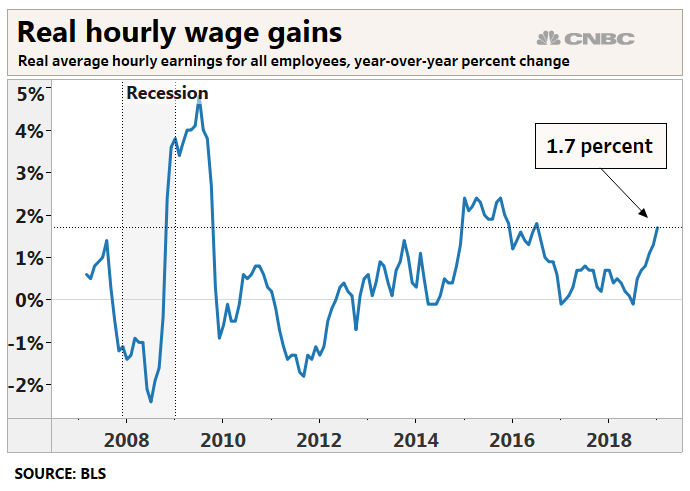Worker paychecks are showing their biggest gains since the recovery began a decade ago, and are more than keeping up with inflation.
Labor Department numbers released Wednesday show that real average hourly earnings, which compare the nominal rise in wages with the cost of living, rose 1.7 percent in January on a year-over-year basis.
A month ago, the increase was 1.3 percent. A year ago, the gain was just 0.7 percent. In all, the rise in inflation-adjusted hourly pay showed the best increase since July 2016.

— Graphic by CNBC's John Schoen
The trend comes amid a steadily rising level in gross average hourly earnings, which increased by 3.2 percent in January, right around the best levels of the recovery as well.
"This is a welcome increase. It gives workers more purchasing power, but because the pickup has been in line with productivity growth and inflation, it has not added to inflationary pressures," Cleveland Fed President Loretta Mester said in a speech Tuesday, before the real wage numbers were released.
Indeed, skeptics about the strength of the gain say wages have barely kept up with inflation, and for a while that was true.
The increase in real average hourly earnings was below 1 percent for two full years straight before November 2018's 1.1 percent gain.
January's consumer price index showed muted overall inflation pressures, but indicated that real average hourly earnings increased by 0.2 percent for the month. Real average weekly earnings rose 0.1 percent for the period, representing a 1.9 percent annualized gain.
For workers, that's meant a better standard of living. At a policy level, the good news likely won't trigger an immediate response from the Federal Reserve, though central bank officials likely are noticing the nascent wage pressures.
"They're looking carefully at a bunch of labor market indicators to figure out how much slack is left," said Bill English, a former senior staffer at the Fed and now a professor at the Yale School of Management. "It's been a complicated thing because there's been a flow of people back into the labor force who left the labor force, and that is great. But the question is how long that can go on, how long you get these substantial gains in payrolls month after month without generating pressure in wages and ultimately in prices."
Payroll gains have averaged a robust 241,000 over the past three months.
Fed officials, though, have indicated they are going to take a pause in the rate-hiking cycle until they get a better feel for how economic conditions are unfolding.


